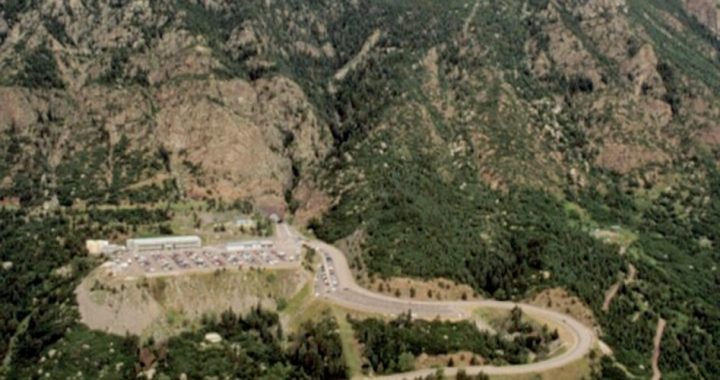
News that NORAD (North American Aerospace Defense Command) was moving back into its previous Cheyenne Mountain underground bunker in Colorado Springs (outside shown) first surfaced during a news conference by NORAD Commander Admiral William E. Gortney on April 7.
It’s moving, said Gortney, “because of the very nature of the way that Cheyenne Mountain is built. It’s EMP-hardened.” EMP, short for an electromagnetic pulse, is a burst of electromagnetic energy produced by a nuclear explosion in the atmosphere, considered capable of widespread damage.
NORAD is also moving because of real world threats by enemies of the United States who now possess the capabilities to launch a nuclear weapon from the south where NORAD is blind.
Gortney explained that North Korea now has operational the KN-08, a nuclear-weapon-armed missile, that can be launched undetected and set off a nuclear explosion sufficient to shut down the entire North American electric grid.
He assured listeners that NORAD is prepared to defend the country from attacks from North Korea and Iran (even if negotiations are successful), provided that those attacks come over the North Pole. But all eyes are facing north, with none facing south.
And that is of great concern to Peter Vincent Pry, executive director of the EMP Task Force, who has written frequently in attempts to warn citizens of the danger. Back in August he joined with James Woolsey, former CIA director, in alerting readers of the Wall Street Journal that “rogue nations such as North Korea (and possibly Iran) will soon match Russia and China and have the primary ingredients for an EMP attack: simple ballistic missiles such as Scuds that could be launched from a freighter near our shores [or] space-launched vehicles able to loft low-earth-orbit satellites [or] simple low-yield nuclear weapons that can generate gamma rays and fireballs.”
It wouldn’t take much to melt the grid, according to Pry:
An EMP strike, most likely from the detonation of a nuclear weapon in space, would destroy unprotected military and civilian electronics worldwide, blacking out the electric grid and other critical infrastructure for months or years.
The staggering human cost of such a catastrophic attack is not difficult to imagine.
Such costs were spelled out in a dystopian novel that made it onto the New York Times best-sellers list back in 2011: One Second After, by William R. Forstchen. It’s the story of how one man struggles to deal with a world that no longer works, first evidenced when cars passing by on the highway come to an immediate and permanent halt thanks to internal computers that no longer work.
In his Afterword to that novel, Forstchen quotes a letter from Captain Bill Sanders of the U.S. Navy, who notes that One Second After is not so much a novel as it is a warning:
An Electronic Pulse (EPM) explosion over the continental United States would have devastating consequences for our country….
A well-designed nuclear weapon detonated at a high altitude over Kansas could have damaging effects over virtually all of the continental United States. Our technologically oriented society and its heavy dependence on advanced electronics systems could be brought to its knees with cascading failures of our critical infrastructure.
Our vulnerability increases daily as our use and dependence on electronics continues to accelerate.
Pry wrote, “Iran should be regarded as already having nuclear missiles capable of making an EMP attack against the U.S. Iran and North Korea have successfully orbited satellites on south-polar trajectories that appear to practice evading U.S. missile defenses, and at optimum altitudes to make a surprise EMP attack.”
Pry decried the failed efforts of Congress (primarily the Senate when it was controlled by the Democrats) to pass legislation that would rectify the shortcomings and close the gaps to the south, such as the GRID Act, the Shield Act, and the Critical Infrastructure Protection Act. Just a few billion dollars would be sufficient to harden at least the most critical military communications network. And transportable radars currently residing in the Philippines could be moved to the West Coast to face south and “help the ground-based interceptors at California’s Vandenberg Air Force defend the country against an attack from the south.”
Gortney isn’t waiting. He’s granted approval to begin the move from Peterson Air Force Base to Cheyenne Mountain, along with granting a $700-million contract to Raytheon to upgrade NORAD’s electronics.
A graduate of an Ivy League school and a former investment advisor, Bob is a regular contributor to The New American magazine and blogs frequently at www.LightFromTheRight.com, primarily on economics and politics.



